
A trolleybus is an electric bus that draws power from dual overhead wires using spring-loaded trolley poles. Two wires, and two trolley poles, are required to complete the electrical circuit. This differs from a tram or streetcar, which normally uses the track as the return path, needing only one wire and one pole. They are also distinct from other kinds of electric buses, which usually rely on batteries. Power is most commonly supplied as 600-volt direct current, but there are exceptions.
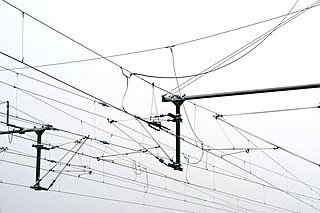
An overhead line or overhead wire is an electrical cable that is used to transmit electrical energy to electric locomotives, electric multiple units, trolleybuses or trams. The generic term used by the International Union of Railways for the technology is overhead line. It is known variously as overhead catenary, overhead contact line (OCL), overhead contact system (OCS), overhead equipment (OHE), overhead line equipment, overhead lines (OHL), overhead wiring (OHW), traction wire, and trolley wire.

An articulated bus, also referred to as a slinky bus, bendy bus, tandem bus, vestibule bus, stretch bus, or an accordion bus, is an articulated vehicle, typically a motor bus or trolleybus, used in public transportation. It is usually a single-decker, and comprises two or more rigid sections linked by a pivoting joint (articulation) enclosed by protective bellows inside and outside and a cover plate on the floor. This allows a longer legal length than rigid-bodied buses, and hence a higher passenger capacity (94–120), while still allowing the bus to maneuver adequately.

Budapesti Közlekedési Zrt. or BKV Zrt. is the main public transport operator in Budapest, Hungary. BKV was established in 1968 as a unified public transport company with the merger of the companies responsible for the different means of transport; bus operator FAÜ, tram and trolleybus operator FVV, suburban railway operator BHÉV and riverboat operator FHV. The metro was added in 1973. The transport in Budapest underwent another reorganization in 2010 when the BKK was founded for the management of the city transport and infrastructure.

A trolley pole is a tapered cylindrical pole of wood or metal, used to transfer electricity from a "live" (electrified) overhead wire to the control and the electric traction motors of a tram or trolley bus. It is a type of current collector. The use of overhead wire in a system of current collection is reputed to be the 1880 invention of Frank J. Sprague, but the first working trolley pole was developed and demonstrated by Charles Van Depoele, in autumn 1885.

A dual-mode bus is a bus that can run independently on power from two different sources, typically electricity from overhead lines like a trolleybus or from batteries like a hybrid bus, alternated with conventional fossil fuel. In contrast to other hybrid buses, dual-mode buses can run forever exclusively on their electric power source (wires). Several of the examples listed below involve the use of dual-mode buses to travel through a tunnel on electric overhead power.

The Saint-Étienne tramway is a tram system in the city of Saint-Étienne in the Rhône-Alpes (France) that has functioned continuously since its opening in 1881. The first tramway line was steam-operated and was opened by the Chemins de Fer à Voie étroite de Saint-Étienne (CFVE) on 4 December 1881, stretching for 5.5 km between La Terrasse and Bellevue. The CFVE took over the Compagnie des Tramways Électriques de Saint-Étienne lines and discontinued the use of steam in 1912.

A bi-articulated bus or double-articulated bus and sometimes train-bus, tram-bus, trackless tram or double bendy bus is a type of high-capacity articulated bus with an extra axle and a second articulation joint, as well as extended length. Bi-articulated buses tend to be employed in high-frequency core routes or bus rapid transit schemes rather than in conventional bus routes.
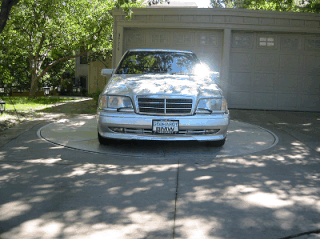
A car turntable or driveway turntable is a rotating platform designed for use by a car; they can be motorized or manually rotated and are usually installed in a driveway or in a garage floor. They rotate a motor vehicle to facilitate its easier or safer egress. Sometimes a local zoning prohibition of vehicles backing onto busy roadways prompts the installation of car turntables.

The Christchurch trolleybus turntable formed part of the Bournemouth trolleybus system, which served the town of Bournemouth and its environs, on the south coast of England. It is still in existence, and is now a Grade II listed building.

The Longwood trolleybus turntable formed part of the Huddersfield trolleybus system, which served the market town of Huddersfield, in West Yorkshire, England.

The Lausanne trolleybus system forms part of the public transport network of Lausanne, in the canton of Vaud, Switzerland. The system has been in operation since 1932 and is the third-oldest surviving trolleybus system in the world, after those of Shanghai and Philadelphia.

The Seattle trolleybus system forms part of the public transportation network in the city of Seattle, Washington, operated by King County Metro. Originally opened on April 28, 1940, the network consists of 15 routes, with 174 trolleybuses operating on 68 miles (109 km) of two-way parallel overhead lines. As of the fourth quarter of 2023, the system carries riders on an average of 39,900 trips per weekday, comprising about 18 percent of King County Metro's total daily ridership. At present in Seattle, a very common alternative term for trolleybus is trolley.

The Solingen trolleybus, also known locally as Stangentaxi, serves the city of Solingen, in the federal state of North Rhine-Westphalia, Germany.

The La Chaux-de-Fonds trolleybus system forms part of the public transport network in La Chaux-de-Fonds, in the canton of Neuchâtel, Switzerland.

The St. Gallen trolleybus system forms part of the public transport network of St. Gallen, the capital city of the canton of St. Gallen, Switzerland.
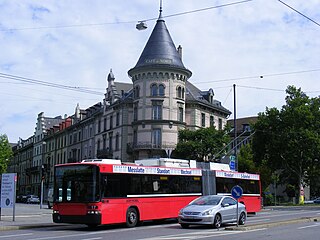
The Bern trolleybus system is part of the public transport network of Bern, the capital city of Switzerland. Opened in 1940, it combines with the Bern S-Bahn, the Bern tramway network and Bern's urban motorbus network to form an integrated all-four style scheme.
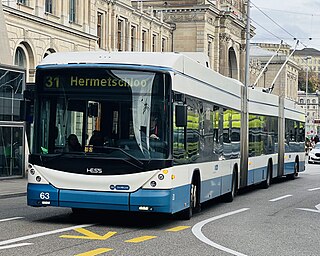
The Zürich trolleybus system is part of the public transport network of Zürich, Switzerland. Opened in 1939, it combines the Zürich S-Bahn, the Zürich tramway network and Zürich's urban motorbus network to form an integrated all-four style scheme.
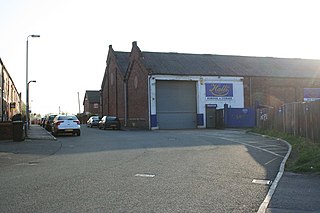
Wigan Corporation Tramways operated a tramway service in Wigan, England, between 1901 and 1931. The first tramway service in the town was run by the Wigan Tramways Company, whose horse trams began carrying passengers in 1880. They began replacing horses with steam tram locomotives from 1882, but the company failed in 1890 when a Receiver was appointed to manage it. The Wigan & District Tramways Company took over the system in 1893 and ran it until 1902. Meanwhile, Wigan Corporation were planning their own tramway system, obtaining an authorising Act of Parliament in 1893, and a second one in 1898. This enabled them to build electric tramways, and in 1902, they took over the lines of the Wigan & District Tramways Company.
At the peak of Britain’s first-generation tramways, it was possible to travel by tram all the way from Pier Head at Liverpool to the Pennines in Rochdale by tram.

The Schaffhausen trolleybus system is part of the public transport network of Schaffhausen, capital city of the canton of Schaffhausen, Switzerland, and the adjacent town of Neuhausen am Rheinfall in the same canton. It is also Switzerland's youngest and smallest such system. Its route, designated as line 1, connects among others Schaffhausen railway station with the Rhine Falls.

























